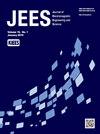用于WLAN应用的盐水光学透明贴片天线
IF 1.7
3区 工程技术
Q3 ENGINEERING, ELECTRICAL & ELECTRONIC
Journal of electromagnetic engineering and science
Pub Date : 2022-11-30
DOI:10.26866/jees.2022.6.r.129
引用次数: 1
摘要
本文介绍了一种新型透明贴片天线的设计、制造和测量,该天线使用盐水,适用于2.4–2.5 GHz的无线局域网(WLAN)。将盐水用于透明天线应用的最重要原因是,与其他典型的透明电极(如氧化铟锡(ITO;OTav>80%)或金属网膜(MMF;OTav>60%)相比,其具有优异的平均光学透明度(OTav>90%)。本研究设计了三种类型的天线:一种具有铜片(CS)导电部件的天线,用于散热器和接地平面(情况1),以与使用盐水作为导电部件的两种类型的透明天线的性能进行比较;具有用于散热器的盐水和用于地平面的MMF的天线(情况2);以及用于散热器和地平面的具有盐水的天线(情况3)。情况1、情况2和情况3的天线分别具有6.87、4.4和1.91dB的峰值增益,并且具有93.5%、62%和34%的相应辐射效率。据我们所知,这是第一次使用盐水演示透明贴片天线。本文章由计算机程序翻译,如有差异,请以英文原文为准。
Optically Transparent Patch Antennas Using Saltwater for WLAN Applications
This paper presents the design, fabrication, and measurement of a novel transparent patch antenna using saltwater with high-opticaltransparency applications for wireless local area networks (WLANs) at 2.4–2.5 GHz. The most important reason for using saltwater for transparent antenna applications is its superior average optical transparency (OTav >90%) compared to other typical transparent electrodes, such as indium tin oxide (ITO; OTav >80%) or metal-mesh film (MMF; OTav >60%). This study designs three types of antennas: an antenna with a conductive part made of copper sheet (CS) for both the radiator and ground plane (case 1) to compare the performance with two types of proposed transparent antennas that use saltwater as the conductive parts; an antenna with saltwater for the radiator and MMF for the ground plane (case 2); and an antenna with saltwater for both the radiator and ground plane (case 3). The case 1, case 2, and case 3 antennas have peak gains of 6.87, 4.4, and 1.91 dB, respectively, and have corresponding radiation efficiencies of 93.5%, 62%, and 34%. To the best of our knowledge, this is the first demonstration of a transparent patch antenna using saltwater.
求助全文
通过发布文献求助,成功后即可免费获取论文全文。
去求助
来源期刊

Journal of electromagnetic engineering and science
ENGINEERING, ELECTRICAL & ELECTRONIC-
CiteScore
2.90
自引率
17.40%
发文量
82
审稿时长
10 weeks
期刊介绍:
The Journal of Electromagnetic Engineering and Science (JEES) is an official English-language journal of the Korean Institute of Electromagnetic and Science (KIEES). This journal was launched in 2001 and has been published quarterly since 2003. It is currently registered with the National Research Foundation of Korea and also indexed in Scopus, CrossRef and EBSCO, DOI/Crossref, Google Scholar and Web of Science Core Collection as Emerging Sources Citation Index(ESCI) Journal. The objective of JEES is to publish academic as well as industrial research results and discoveries in electromagnetic engineering and science. The particular scope of the journal includes electromagnetic field theory and its applications: High frequency components, circuits, and systems, Antennas, smart phones, and radars, Electromagnetic wave environments, Relevant industrial developments.
 求助内容:
求助内容: 应助结果提醒方式:
应助结果提醒方式:


